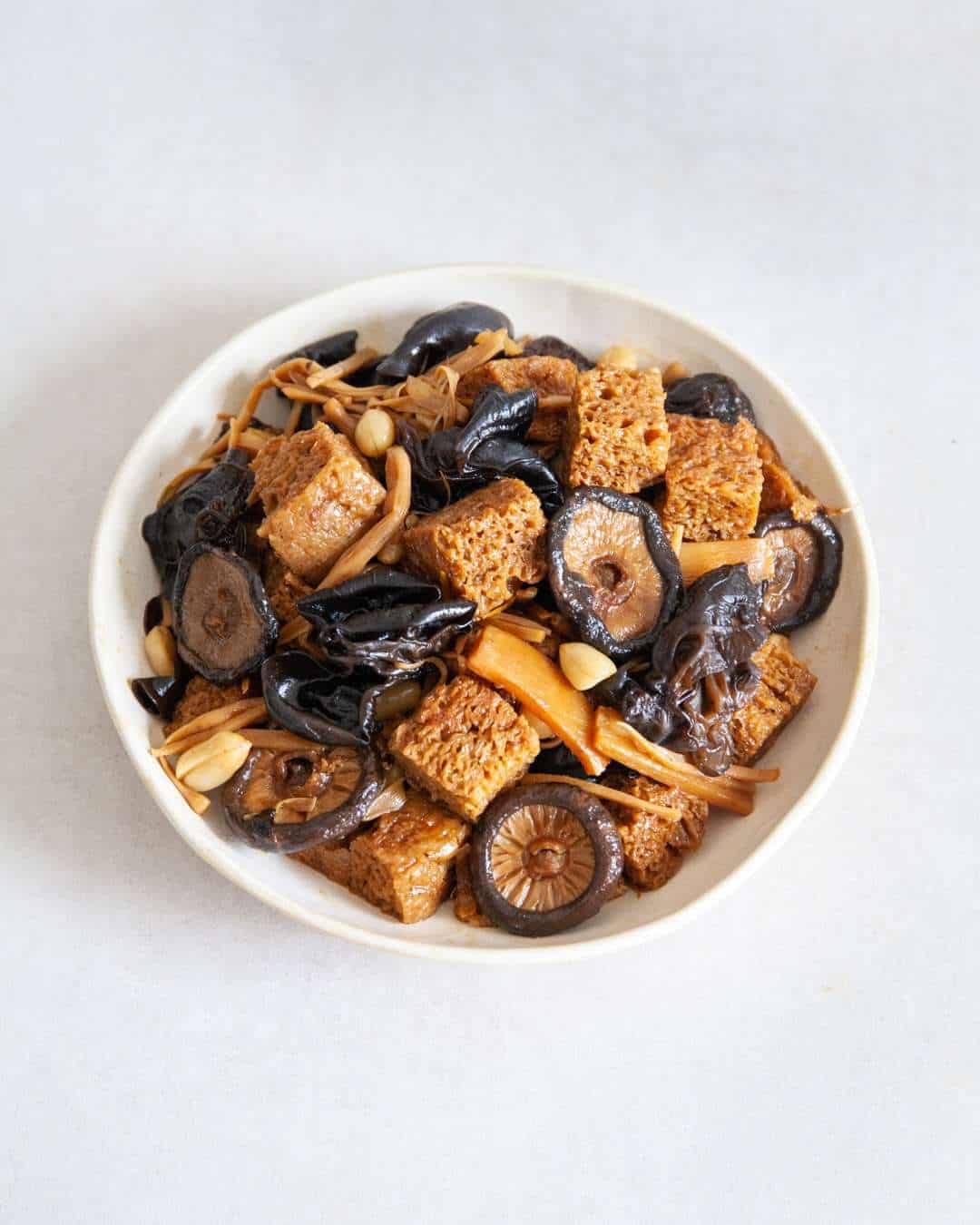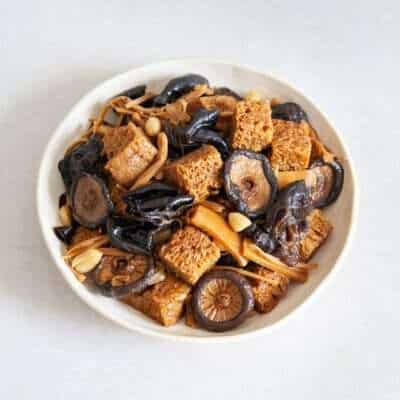Braised Wheat Gluten (Kao Fu 烤麩)

What is Braised Wheat Gluten (Kao Fu 烤麩)?
Chinese Braised Wheat Gluten, also known as Kao Fu (烤麸), is a traditionally vegan dish often enjoyed as an appetizer or side dish in Chinese cuisine. It’s made from wheat gluten, which is a traditional plant-based protein derived from wheat flour. Once prepared, Kao Fu is braised in a flavorful soy-based sauce, typically with the addition of mushrooms, wood ear fungus, bamboo shoots and peanuts. The gluten’s texture is spongy, chewy and highly absorbent, making it ideal for soaking up the savory, umami-rich flavors of the braising sauce. Kao Fu is especially popular in Shanghainese cuisine and often served cold or at room temperature.
History of Braised Wheat Gluten (Kao Fu 烤麩)
The history of Kao Fu dates back centuries and is deeply rooted in Chinese culinary traditions. It was originally invented by Buddhist monks, who, following a vegetarian diet, were looking for ways to offer meat-like textures to visitors of their monasteries. So in many ways it can be seen as the original version of fake meat. The braising technique and the inclusion of ingredients like mushrooms and soy sauce reflect the broader influence of regional flavors, particularly in Shanghai.
Today, many different forms of wheat gluten exist, hailed for their texture as well as their high protein content. On a commercial level, they have saturated the market under the name ‘seitan’, which was coined in 1961 by the Japanese macrobiotic diet advocate George Ohsawa.
Ingredients You’ll Need & How to Substitute
To make Kao Fu, you’ll need the following ingredients:
- Wheat Gluten: The primary ingredient that gives the dish its unique chewy texture. You can also make your own wheat gluten from scratch.
- Dried Shiitake Mushrooms: Add a rich umami flavor; fresh mushrooms can be used if available.
- Dried Black Fungus: Provides a unique texture; you can substitute with other mushrooms if needed.
- Dried Lily Flower: Enhance the dish’s visual appeal and add a delicate taste; they can be omitted if unavailable.
- Raw Blanched Peanuts: Add crunch and richness; roasted peanuts or cashews can be used as substitutes.
- Bamboo Shoots: Bring refreshing crunch; fresh bamboo shoots can also be used if accessible.
- Ginger: Provides warmth and depth of flavor; ground ginger can be used in a pinch, though fresh is preferable.
- Light Soy Sauce: Essential for seasoning; tamari works as a gluten-free alternative.
- Dark Soy Sauce: Adds a deeper color and flavor; you can substitute with additional light soy sauce if necessary.
- Shaoxing Wine: Elevates the taste profile; dry sherry or rice vinegar can be used as a substitute.
- Golden Granulated Sugar: Adds a hint of sweetness; coconut sugar or maple syrup can be alternatives.
- Toasted Sesame Oil: Adds richness; you can omit it if unavailable.
- Cooked Rice: Served alongside Kao Fu for a complete meal.
How to make Kao Fu (step-by-step)
Soak the Ingredients. Add the wheat gluten to a large bowl and cover it with cold water. Leave to soak for 2 hours until soft. In a separate bowl, combine the shiitake mushrooms, dried black fungus, dried lily flowers and peanuts. Cover them with cold water and let them soak for 2 hours as well. Once the gluten is soft, drain and briefly rinse it under cold water, then squeeze out most of the liquid. Drain the other ingredients but reserve their soaking liquid.
Fry the Bamboo Shoots and Ginger. Drain the bamboo shoots and julienne the ginger. Heat some oil in a large casserole, wok or frying pan with a lid. Fry the bamboo shoots and ginger until the ginger begins to turn golden, about 6-8 minutes.
Cook the Mushrooms and Other Ingredients. Add the remaining soaked ingredients (except for the gluten) to the pan and continue frying for another 2 minutes. Set everything aside and add a bit more oil to the pan.
Fry the Wheat Gluten. Fry the gluten until golden around the edges. Be cautious, as it may stick to the bottom of the pan. Avoid forcing it loose, as this can tear the gluten.
Braise the Kao Fu. Return the set-aside ingredients to the pan. Pour in the light soy sauce, dark soy sauce, Shaoxing wine, sugar and 750 ml of the reserved soaking liquid. The gluten should loosen by itself. Bring the liquid to a boil, then reduce the heat, cover with a lid and simmer for 30 minutes.
Reduce the Liquid. Remove the lid and continue cooking until almost all of the liquid has evaporated, about 15-30 minutes. If serving with rice, prepare it now.
Finish and serve. Turn off the heat and stir in the sesame oil. Traditionally, Kao Fu is served as a cold appetizer, but you can also enjoy it warm if you prefer.
Useful Tips
- Homemade wheat gluten: You can make your own wheat gluten (kao fu) with just flour and water.
- Non-stick frying pan: If the wheat gluten sticks to the casserole, fry it in a non-stick frying pan first.
- Serve with rice: Serve the Kao Fu alongside freshly steamed rice for a full meal.
Why You’ll Love This Kao Fu Recipe
- naturally and traditionally vegan
- unique chewy texture
- high in protein
- rich in umami
How to Store Kao Fu
To store Kao Fu, keep leftover portions in an airtight container in the refrigerator for 3-4 days. Reheat in a pan until warmed through. For longer storage, freeze the dish in portions for up to three months for convenient meal prep.
**I receive a small commission from affiliate links on this page**

Braised Wheat Gluten (Kao Fu 烤麩)
Ingredients
- 160 g dried wheat gluten/kao fu (or 1x homemade wheat gluten)
- 40 g dried shiitake mushrooms
- 30 g dried black fungus (wood ear mushrooms)
- 25 g dried lily flower
- 70 g raw blanched peanuts
- 225 g tin Bamboo shoots (140g drained weight)
- 60 g ginger
- 4 tbsp light soy sauce
- 2 tbsp dark soy sauce
- 2 tbsp Shaoxing wine
- 1 tbsp golden granulated sugar
- 1 tbsp toasted sesame oil
- Cooked rice to serve
Instructions
- Add the wheat gluten to a large bowl and cover it with 1.25l of water, then leave to soak for 2 hours until soft (is using homemade wheat gluten, skip this step). To a separate bowl, add the shiitake mushrooms, dried wood ear mushrooms, dried lily-flower and peanuts. Cover them with the same amount of water and leave to soak for 2 hours as well.
- When the gluten is soft, drain it and briefly rinse it under cold water, then squeeze out most of the liquid. Drain the other ingredients but keep their soaking liquid. Drain the bamboo shoots and julienne the ginger.
- Heat some oil in a large casserole, wok or frying pan for which you have a lid and fry the bamboo shoots and ginger until the ginger begins to turn golden (6-8 min). Now add the remaining soaked ingredients apart from the gluten and continue to fry it for another 2 minutes. Set everything aside and add a bit more oil to the pan. Then fry the gluten until golden around the edges. Unless you’re using a non-stick pan, it’ll most likely stick to the bottom. Don’t try to loosen it with force as it’ll tear the gluten into smaller pieces. Instead return the set aside ingredients to the pan and pour in the light soy sauce, dark soy sauce, the Shaoxing wine, sugar and 750 ml of the reserved soaking liquid. The gluten should now loosen by itself.
- Bring the liquid to a boil, then reduce the heat and simmer covered for 30 minutes. Remove the lid and continue cooking until almost all of the liquid has evaporated (another 15-30 min). If you’re serving it with rice, make sure to cook it now.
- Turn off the heat and stir in the sesame oil. Traditionally, Kao Fu is served as a cold appetiser, but you can also eat it warm if you like.
